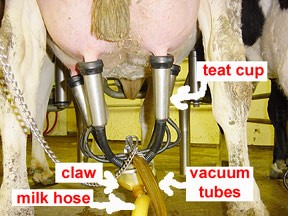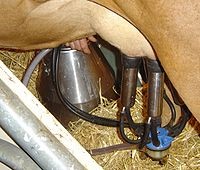The milking machine is a system consisting of various parts that work in combination with each other to milk a number of cows at the same time. The following parts form the basic framework of the milking machine:
- Claw
- Teat cups
- Milk tubes (many different shapes and sizes)
- Pulsator
- Bulk tank

Milking machines are used to extract milk from cows when the herd is larger than about 4 cows. The milking unit is the portion of a milking machine for removing milk from an udder. It is made up of a claw, four teat cups, a long milk tube, a long pulsator tube, and a pulsator.
The claw is a manifold that connects the short pulse tubes and short milk tubes from the teat cups to the long pulse tubes and long milk tubes. Claws are commonly made of stainless steel or plastic. Teat cups are composed of a rigid outer shell (stainless steel or plastic), which holds a soft inner liner or inflation. Transparent sections in the shell may allow viewing of liner collapse and milk flow. The annular space between the shell and liner is referred to as the pulsation chamber.

Milking machines work in a way that is different from hand milking or calf suckling. A continuous vacuum is applied inside the soft liner to withdraw milk from the teat by creating a pressure difference across the teat canal (or opening at the end of the teat). The vacuum also helps keep the machine attached to the cow. The vacuum applied to the teat causes congestion of teat tissues (accumulation of blood and other fluids). Atmospheric air is admitted into the pulsation chamber about once per second (the pulsation rate), to allow the liner to collapse around the end of the teat and relieve congestion in the teat tissue. The ratio of the time that the liner is open (milking) and closed (massaging or resting) is called the pulsation ratio.
The four streams of milk from the teat cups are usually combined in the claw and transported to the milk line or collection bucket (usually sized to the output of one cow) in a single milk hose. Milk is then transported (manually in buckets) or with a mechanical pump to a central storage vat or bulk tank. Milk is refrigerated on the farm in most countries either by passing through a heat-exchanger or in the bulk tank.

The photo above is of a bucket milking system with the stainless-steel bucket visible on the far side of the cow. The two rigid, stainless steel teat cup shells applied to the front two-quarters of the cow are visible. The top of the flexible liner is visible at the top of the shells as are the short milk tubes and short pulsation tubes extending from the bottom of the shells to the claw. The bottom of the claw is transparent to allow visualization of milk flow. When milking is completed the vacuum to the milking unit is shut off and the teat cups are removed.
Milking machines keep the milk enclosed and safe from external contamination. The interior 'milk contact' surfaces of the machine are kept clean by a manual or automated washing procedure implemented after milking is completed twice or three times per day.
Milk contact surfaces must comply with regulations ensuring that they are food-grade materials (typically stainless steel and special plastics and rubber compounds) and are easily cleaned.
Most milking machines are powered by electricity but, in case of electrical failure, there can be an alternative means of motive power, often an internal combustion engine, for the vacuum and milk pumps because milking cows cannot tolerate delays in their scheduled milking without suffering serious milk production reductions.
Click here to view a video that explains the milking machines.